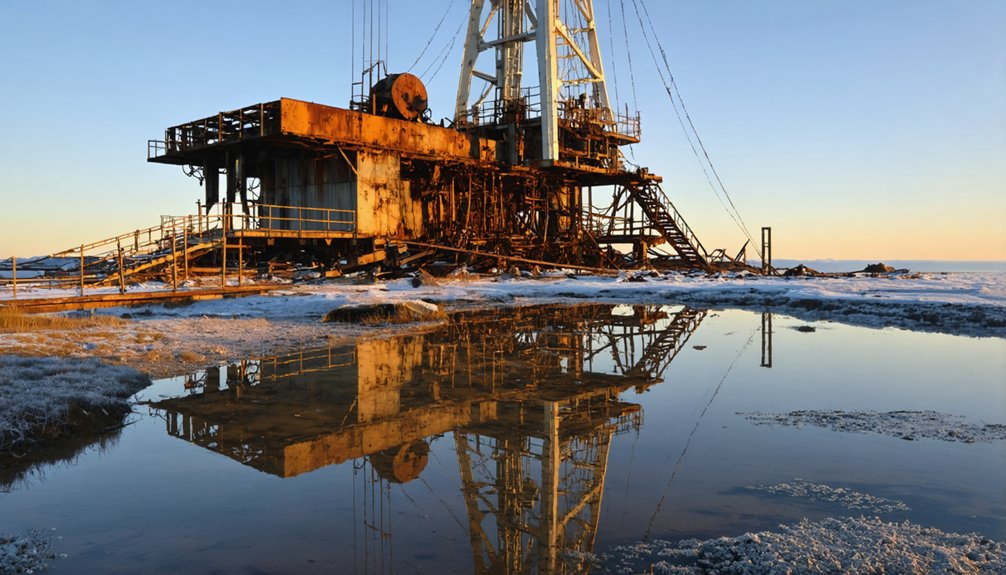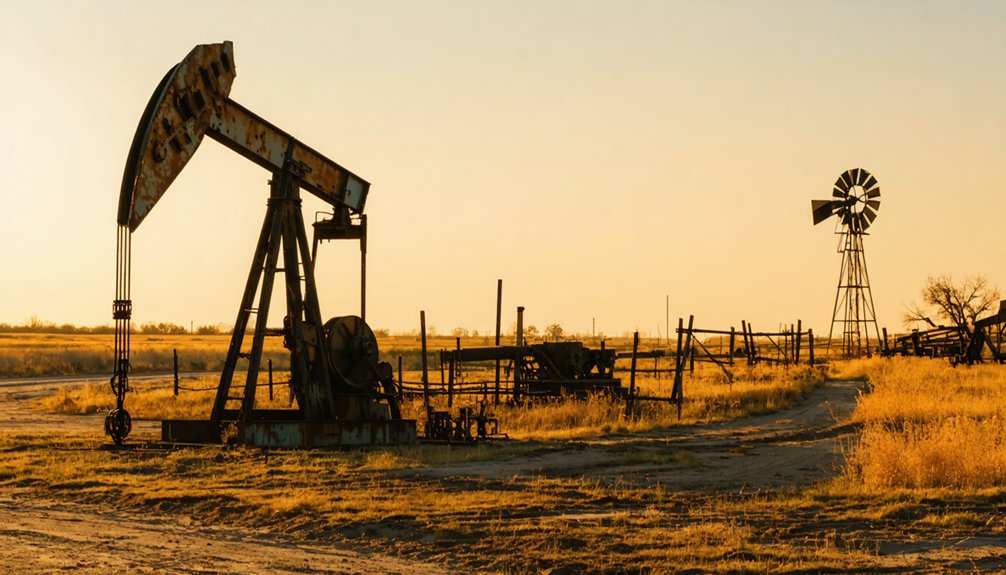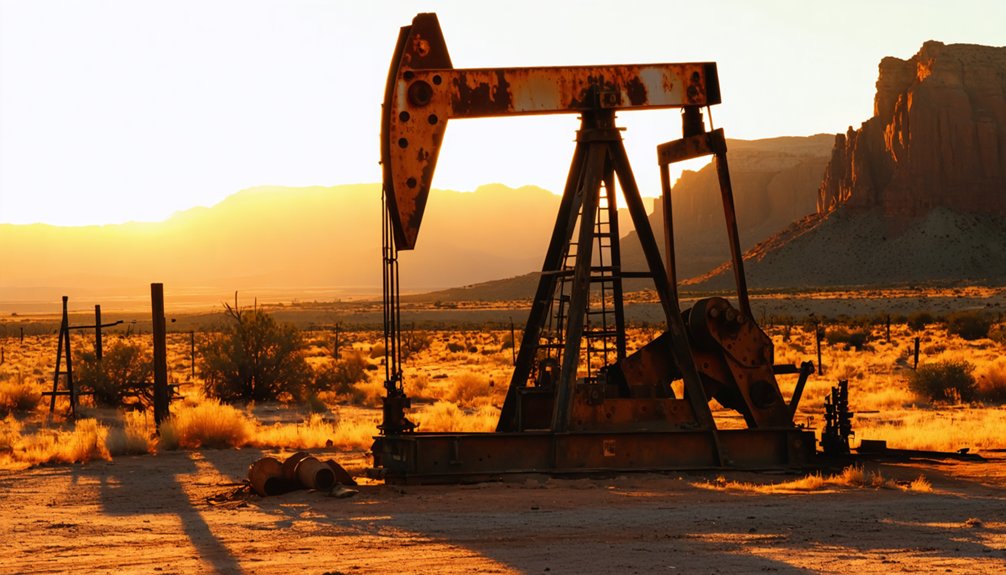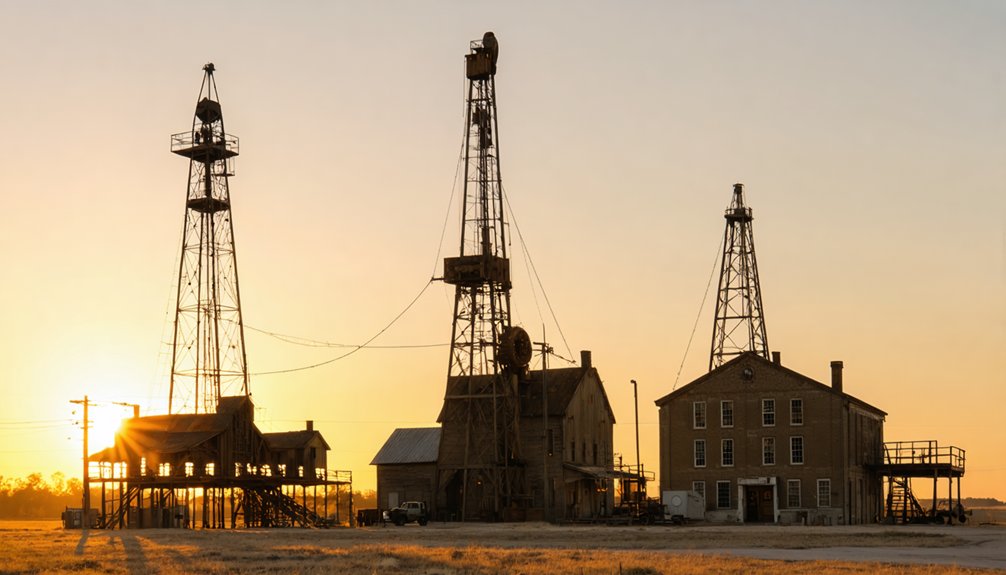You’ll discover America’s most significant abandoned oil sites at Edwin Drake’s 1859 Pennsylvania well, where modern drilling began, followed by Oklahoma’s 1905 Glenn Pool Field and Texas’s vast Permian Basin. California’s Signal Hill, Alaska’s Naval Reserve wells, and Louisiana’s coastal operations showcase the industry’s evolution. West Virginia’s Burning Springs, Wyoming’s Salt Creek, and New Mexico’s Hogback Field round out these historic locations. Each site holds untold stories of innovation, boom cycles, and environmental challenges.
Key Takeaways
- Drake Well in Titusville, Pennsylvania marks the birthplace of American oil industry, producing 20 barrels daily after striking oil in 1859.
- Glenn Pool Oil Field in Oklahoma produced 46 million barrels by 1907, making it one of America’s most significant early oil discoveries.
- Signal Hill’s Alamitos #1 well in California struck oil in 1921, reaching peak production of 260,000 barrels daily by 1923.
- The Texas Permian Basin contains over 100,000 idle wells, including 7,000 orphaned wells requiring nearly $1 billion in cleanup costs.
- Alaska’s Naval Petroleum Reserve includes 136 abandoned test wells drilled between 1944-1982, many threatening wildlife and local ecosystems.
The Historic Drake Well: Birthplace of American Oil Industry in Pennsylvania
A pioneering monument to America’s oil industry, the Drake Well near Titusville, Pennsylvania, launched the modern petroleum era in 1859.
You’ll find this groundbreaking site where Edwin Drake and “Uncle Billy” Smith first struck oil at a depth of 69.5 feet using innovative salt-well drilling techniques.
Drake’s revolutionary method of driving cast iron pipes into the ground prevented wellbore collapse, producing 20 barrels daily and sparking America’s first oil boom.
This oil innovation transformed Pennsylvania into the nation’s leading petroleum producer, accounting for over half of U.S. output through 1892.
The well achieved an impressive thousand gallons daily yield for three consecutive years following its discovery.
While the original structure burned, you can now explore the 240-acre Drake Well Museum and Park, featuring a reconstructed cable-tool derrick, steam engine house, and artifacts that showcase the birth of commercial oil drilling in America.
The site was officially recognized for its historical importance when it was listed on the National Register of Historic Places in 1966.
Texas Permian Basin’s Ghost Fields: A Legacy of Boom and Bust
Moving east from Pennsylvania’s pioneering oil fields, the Texas Permian Basin emerged as America’s next great petroleum frontier in 1920 when William H. Abrams made his groundbreaking discovery in Mitchell County.
You’ll find the region’s oil heritage began with Santa Rita No. 1, which transformed a once-called “petroleum graveyard” into America’s highest-producing oilfield.
Today, you’re witnessing the aftermath of multiple boom-bust cycles, with over 100,000 idle wells dotting the landscape. These ghost fields tell a stark story: 7,000 orphaned wells threatening groundwater and creating sinkholes across Texas and New Mexico. The COVID-19 pandemic intensified the region’s struggles, driving 46 North American oil companies into bankruptcy by late 2020.
The cleanup challenge is massive – nearly $1 billion needed to address contamination risks. You’ll see this legacy particularly in towns like Midland and Hobbs, where abandoned wells stand as silent sentinels of the Permian Basin’s volatile history. Pecos County alone produces 3 million barrels monthly, demonstrating the region’s continued significance despite its environmental challenges.
Eagle Ford Shale’s Forgotten Wells: South Texas Oil Heritage
Eagle Ford Shale’s most concentrated drilling sites spanning a 400-mile stretch across southern Texas, where over 7,000 wells have transformed the landscape since 2008’s unprecedented production surge.
The environmental toll has become increasingly apparent through documented groundwater contamination from abandoned wells, with studies showing 30 contamination events between 1993-2008 and ongoing threats to water sources and soil quality. Recent data indicates toxic minerals are seeping into vital aquifers, creating long-term environmental hazards. Daily inspections were required after a major well blowout in December that released 14,000 gallons of water per hour.
Local Hispanic communities have shouldered a disproportionate burden of the environmental impacts, while cleanup efforts face mounting challenges with estimates suggesting nearly $1 billion will be needed to properly plug and restore Texas’s abandoned wells.
Historical Drilling Site Distribution
Throughout the vast expanse of South Texas, the Eagle Ford Shale formation stretches across 7 million acres and 15 counties, creating one of America’s most significant oil-producing regions.
You’ll find this productive zone extending 400 miles from the Texas-Mexico border in Webb and Maverick counties, reaching northeast toward East Texas in a belt roughly 50 miles wide.
The landscape’s history of exploratory drilling began in 2008 when Petrohawk Energy Corporation drilled the first well in La Salle County. The formation’s unique high carbonate content made drilling operations notably successful due to the rock’s natural brittleness.
Since then, over 19,000 horizontal wells have transformed the region. The area’s forgotten wells, remnants of earlier drilling attempts from the 1930s through 1950s, dot the countryside.
These abandoned sites, many now hidden by time and vegetation, tell the story of South Texas’s pioneering spirit in oil exploration. Daily production peaked at 2.62 million BOE/day in March 2015, marking the height of the region’s oil boom before the industry downturn.
Environmental Impact Assessment Today
The legacy of Eagle Ford’s pioneering drilling operations now presents significant environmental challenges across South Texas.
You’ll find that inadequate environmental monitoring has led to widespread contamination risks, with over 7,000 orphaned wells threatening soil and groundwater quality. Limited detection capabilities make it difficult to track pollutant migration through these abandoned sites. The Texas Railroad Commission has spent over 243 million dollars addressing these environmental hazards through strategic well-plugging initiatives. Analysis showed a 400% increase in flaring since 2009 throughout the region.
- Leaking wells release thousands of gallons of contaminated water hourly, creating black sludge pools toxic to wildlife.
- Flaring operations waste 35+ billion cubic feet of gas annually while exposing rural communities to hazardous emissions.
- Failed well casings act as direct pathways for hydrocarbons and brine to infiltrate crucial aquifers.
Current contamination prevention efforts rely on advanced technologies like drone surveys and methane sensors, though funding constraints limit thorough remediation of these industrial remnants.
Community Response Over Time
Since Eagle Ford’s first commercial drilling in 2008, local communities have witnessed a dramatic transformation of South Texas’s economic and environmental landscape.
You’ll find that community awareness evolved from initial limited recognition to heightened environmental activism as drilling permits skyrocketed from 26 to 4,000 by 2013.
You’ve seen how residents adapted their response strategies over time, shifting from passive acceptance during the economic boom to active engagement when health concerns emerged.
Local landowners have developed technical expertise about well operations, while environmental groups tackle air-quality monitoring challenges.
As abandoned wells multiply, you’re witnessing increased community organizing around regulatory accountability, particularly regarding cleanup delays and contamination risks.
Public pressure has intensified for stricter oversight of orphaned wells and faster remediation timelines.

You’ll find fascinating evidence of America’s wartime oil exploration in Alaska’s Naval Petroleum Reserve, where the U.S. Navy drilled 136 test wells between 1944 and 1982 across 23 million acres of Arctic terrain.
These legacy wells, ranging from 4,000 to 20,000 feet deep, now present significant environmental challenges due to coastal erosion, permafrost thaw, and abandoned infrastructure.
The remote locations and harsh Arctic conditions make cleanup operations particularly complex, though the Bureau of Land Management continues remediation efforts to protect public health and restore the landscape.
When President Warren G. Harding established Naval Petroleum Reserve No. 4 in 1923, he set the stage for one of America’s most ambitious Arctic drilling ventures.
You’ll find the roots of naval exploration on Alaska’s North Slope, where the U.S. Navy launched intensive operations in 1944 to secure wartime oil supplies.
- The 1058th Naval Construction Battalion transported 8,000 tons of equipment across the frozen tundra.
- Seabees constructed camps and airfields at Cape Simpson and Umiat in harsh Arctic conditions.
- Navy-USGS teams drilled 35 core test wells between 1943-1953, pioneering modern Arctic drilling techniques.
The Navy’s determination led to discovering multiple oil-bearing sand layers, though no major commercial fields emerged.
Their legacy wells, totaling 136 by 1982, opened up America’s last frontier and laid the groundwork for future Arctic petroleum exploration.
Environmental Impact Today
The environmental legacy of Naval Petroleum Reserve drilling operations continues to plague Alaska’s North Slope through 137 improperly abandoned wells drilled between 1944 and 1981.
You’ll find these environmental hazards threatening wildlife, ecosystems, and local communities across the region. Leaking hydrocarbons and drilling wastes contaminate groundwater, soil, and surface water, while oilfield brine spills create dead zones of vegetation.
The abandoned wells directly impact critical wildlife, disrupting caribou migrations essential for Inuit subsistence hunting and stressing threatened polar bear populations.
You’re seeing ongoing degradation of aquatic ecosystems near Teshekpuk Lake, affecting migratory birds and fish. Local communities face health risks from PAH exposure, while physical hazards from eroding wellheads pose additional safety concerns.
The BLM’s remediation efforts remain hampered by funding challenges.
Remote Cleanup Challenges
Despite decades of technological advancement, cleaning up Alaska’s 136 legacy wells presents unprecedented challenges in the harsh Arctic environment.
You’ll find that remediation strategies require precise seasonal timing and specialized equipment to navigate the extreme conditions. The logistical considerations are complex, demanding careful coordination of resources across vast distances.
When you’re planning cleanup operations, you’ll encounter these major obstacles:
- Limited access routes requiring ice roads, helicopters, or barges for transporting heavy equipment
- Technical complexities of plugging wells with deteriorated casings and unknown subsurface conditions
- Cultural preservation requirements that restrict site disturbance while managing scattered debris and contaminated materials
With costs reaching millions per well and limited annual funding of $1 million, you’re looking at decades of sustained effort to complete this massive undertaking.
Oklahoma’s Glenn Pool Oil Field: America’s First Major Oil Discovery

Located on Ida Glenn’s farm near Tulsa, Oklahoma, the Glenn Pool Oil Field marked a pivotal moment in American petroleum history when drillers Robert Galbreath and Frank Chesley struck oil at 1,481 feet on November 22, 1905.
After noticing oil seepage in limestone outcrops, they drilled the discovery well, which initially produced 85 barrels per day.
You’ll find that Glenn Pool triggered Oklahoma’s first major oil boom, transforming Tulsa into the “Oil Capital of the World” from 1907 to 1930.
By 1907, the field’s production soared to 46 million barrels, outperforming all other U.S. states. The field’s light, sweet crude proved ideal for gasoline production, leading to the construction of major pipelines connecting to refineries in Texas and Indiana.
Today, while the discovery well site remains unmarked, Glenn Pool’s legacy lives on through its 325.5-million-barrel contribution to America’s energy independence.
California’s Signal Hill: From Black Gold Rush to Abandoned Infrastructure
When you visit Signal Hill today, you’ll find it hard to imagine that this site erupted into California’s most dramatic oil discovery on June 23, 1921, when Shell Oil’s Alamitos #1 well struck oil at 3,114 feet.
Within just two years, the field transformed into a forest of derricks producing 260,000 barrels daily, earning the nickname “Porcupine Hill” and propelling California to supply a quarter of the world’s oil output.
Now, the once-bustling oilfield stands largely depleted with approximately 5 million recoverable barrels remaining, marked by abandoned infrastructure and environmental concerns from idle wells that demand ongoing remediation efforts.
Early Boom Days Rise
After numerous failed attempts to strike oil in Signal Hill during the 1910s, Royal Dutch Shell‘s persistence finally paid off in 1921 when Alamitos Well Number 1 erupted at 3,114 feet, releasing California’s next great oil boom.
You’ll find these remarkable statistics from the early days of Signal Hill’s transformation:
- Within just one year, 108 wells were pumping 14,000 barrels daily
- By 1923, the field reached peak production of 260,000 barrels per day
- The area produced 25% of the world’s total oil output
The discovery triggered an overnight rush of derricks, turning Signal Hill into “Porcupine Hill.”
Oil companies raced to secure every available acre, while drillers like O.P. “Happy” Yowells and Frank Hays pushed deeper than ever before, defying earlier skepticism from geologists like Dr. W. Van Holst Pellekaan.
Environmental Legacy Today
The environmental aftermath of Signal Hill’s oil boom persists today through a sobering landscape of abandoned infrastructure, where you’ll find over 200 defunct wells dotting the region’s residential neighborhoods and business districts.
These abandoned wells pose significant environmental risks, leaking methane and toxic chemicals into the surrounding soil and air.
You’re likely to encounter elevated levels of heavy metals and hydrocarbons in soil samples near these sites, while air quality monitors frequently detect dangerous pollutant spikes.
If you live near these areas, you’ll face increased health risks, including respiratory issues and potential long-term exposure effects.
The challenge of cleaning up these sites continues to grow, with California facing billions in liability costs while regulatory oversight remains inconsistent and enforcement gaps persist.
New Mexico’s Hogback Field: Ancient Wells Among Native Lands

Located in Rio Arriba County, New Mexico’s historic Hogback Field stands as a tribute to early 20th-century oil exploration, where initial drilling efforts in 1922 yielded impressive results.
You’ll find wells like Hogback No. 1 producing 375 BOPD near Shiprock, marking the beginning of significant regional development. Today, the field’s legacy intersects with cultural preservation and environmental justice concerns on Native American lands.
- Ancient oil tanks rust against desert landscapes, their skeletal frames casting long shadows across tribal territories.
- Abandoned wellheads pierce the earth like forgotten monuments, leaking methane into sacred grounds.
- Archaeological sites and native ecosystems struggle against decades of industrial neglect.
The field’s complex geology, marked by the Hogback monocline and Pennsylvanian-age reservoirs, now presents a challenging cleanup mission that’ll cost taxpayers millions while threatening cultural heritage.
West Virginia’s Oil and Gas Legacy: Appalachian Basin’s Hidden History
Deep within Appalachia’s rugged terrain, West Virginia’s oil and gas legacy began in 1859 when drillers struck oil at Burning Springs, launching a transformative era of energy exploration.
You’ll find this pioneering site within the resource-rich Appalachian Basin, where early prospectors discovered both gas and oil while drilling for salt.
The oil industry flourished until Confederate raiders destroyed Burning Springs in 1863, but determined wildcatters rebuilt and expanded operations across the state.
Production peaked around 1900, with major discoveries in the Devonian black shales and Oriskany Sandstone formations.
Today, you can explore thousands of historic well sites that dot the landscape, from Petroleum to California, WV.
These abandoned operations tell the story of America’s earliest energy boom, though they’ve left behind environmental challenges that now require innovative solutions.
Louisiana’s Abandoned Gulf Coast Wells: A Century of Coastal Drilling
While West Virginia pioneered early oil exploration in Appalachia, Louisiana’s oil legacy began in 1901 with a successful well in Jennings that sparked an unprecedented coastal drilling boom.
You’ll find America’s first over-water drilling operations at Caddo Lake near Shreveport in 1910, setting the stage for Gulf Coast expansion.
By the 1930s, drilling regulations couldn’t keep pace with thousands of wells dotting Louisiana’s fragile coastline.
- Coastal erosion has submerged countless original well sites, with 3,654 abandoned wells documented
- Only 12 of these wells still produce oil, while thousands potentially leak methane and crude
- Storm damage and shifting shorelines expose aging infrastructure, creating environmental hazards
Today’s legacy reflects a century of unchecked expansion, with many wells now orphaned and unmonitored beneath Gulf waters.
Wyoming’s Salt Creek Oil Field: Pioneer Valley’s Dormant Giants
The historic Salt Creek Oil Field stands as America’s pioneering petroleum hub, stretching across 45 square miles near Midwest, Wyoming. You’ll find this remarkable site first tapped its liquid gold in the 1880s, becoming one of the world’s longest-producing fields.
By 1923, you could’ve witnessed its peak production of 35.3 million barrels annually, transforming a quiet valley into a bustling 17,000-person boomtown.
Salt Creek’s peak in 1923 turned Wyoming wilderness into a thriving metropolis, as oil transformed the land and its people.
While the 1930s brought decline and abandonment of numerous wells, Salt Creek’s story didn’t end there. You’re looking at an impressive oil resurgence through modern technology, as Anadarko Petroleum’s CO2 injection methods breathed new life into these dormant giants.
Today, the field continues producing around 10,000 barrels daily, proving that even century-old petroleum sites can adapt and thrive with innovative extraction techniques.
Frequently Asked Questions
How Do Abandoned Oil Wells Affect Property Values in Surrounding Residential Areas?
Your property’s value will drop considerably near abandoned wells due to market perception of environmental risks, with studies showing up to 50% decline in development potential and decreased buyer interest.
What Are the Cultural Preservation Challenges When Abandoned Wells Exist on Tribal Lands?
Like scars on sacred ground, you’ll face deep barriers protecting cultural significance when wells fragment tribal sovereignty, damage ceremonial sites, and complicate preservation efforts through jurisdictional conflicts and insufficient documentation.
Can Abandoned Oil Wells Be Repurposed for Geothermal Energy Production?
You’ll find significant geothermal potential in abandoned wells through proper repurposing, achieving temperatures up to 67°C and heat extraction of 857kW using closed-loop systems with double-layer insulation pipes at 4,800m depths.
How Do Insurance Companies Handle Claims Related to Abandoned Well Damages?
With $25 million liability limits, you’ll face a complex claims process where insurers assess ownership history, evaluate pollution damage, and determine responsibility before paying for cleanup and plugging costs through specialized coverage policies.
Which Cleaning Technologies Are Most Cost-Effective for Remediating Contaminated Well Sites?
You’ll find bioremediation techniques most cost-effective for large-scale cleanups, especially bioventing and oxygen-releasing compounds. Cost analysis shows they’re 60-80% cheaper than chemical treatments while offering sustainable, long-term results.
References
- https://www.texastribune.org/2016/12/21/texas-abandoned-oil-wells-seen-ticking-time-bombs/
- https://www.science.gov/topicpages/a/abandoned+in-situ+oil
- https://grist.org/abandoned-oil-gas-wells-permian-texas-new-mexico/
- https://www.heienergy.org/system/files/hei-energy-brief-4-abandoned-wells.pdf
- https://www.archaeologysouthwest.org/2024/02/28/report-orphaned-wells-and-abandoned-oil-and-gas-infrastructure-pose-a-significant-threat-to-cultural-resources-in-the-southwest/
- https://www.texastribune.org/2016/12/21/texas-abandoned-oil-wells-seen-ticking-time-bombs-/
- https://www.nps.gov/articles/000/biso-abandoned-wells.htm
- https://www.statista.com/statistics/1135734/us-abandoned-oil-gas-wells/
- https://pubs.usgs.gov/publication/dr1167/full
- https://www.science.gov/topicpages/a/abandoned+oil+wells



